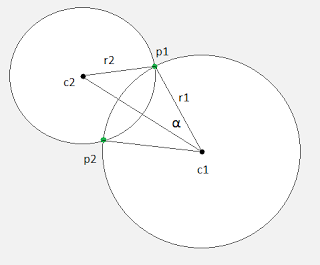Hello Codeforces community,
In problem D (Area of Two Circles' Intersection), I wanted to calculate the angle between two vectors.

I calculated the angle α using the dot and cross products of the vectors c1p1 (name it V1) & c1c2 (name it V2) using the following equation:

Then used the atan2 function to get the angle. I got a WA with a small precision drift in test 41. I changed the implementation to what was described in the editorial and calculated α using the low of cosines as follows:

where d is the distance between the centers of the circles. I used the acos function to get the angle, this passed the system tests.Those are the links of my submissions:
Wrong: http://codeforces.net/contest/600/submission/27546617
Correct: http://codeforces.net/contest/600/submission/27546673
I wonder why my first approach failed.
Another problem, Nearest Vectors:You are given the set of vectors on the plane, each of them starting at the origin. Your task is to find a pair of vectors with the minimal non-oriented angle between them.
I sorted the vectors w.r.t their angles, then looped on them minimizing the value of angle[i + 1] — angle[i]. I wrote the following function to get the angle between each vector and the positive direction of the X-Axis
long double get_ang(pii coords) {
double res = atan2(coords.second, coords.first);
if (res < 0) res += 2 * PI;
return res;
}
This gave me WA in a test case 140, where 2 answers were very close in the difference. I modified the function and converted the angles to degrees and it passed.
long double get_ang(pii coords) {
double res = atan2(coords.second, coords.first) * 180 / PI;
if (res < 0) res += 2 * PI;
return res;
}
Wrong submission: http://codeforces.net/contest/598/submission/27534014
Correct submission: http://codeforces.net/contest/598/submission/27534469
I also wonder how this very slight modification affected the differences between angles.










For the first problem, test 41 are one large circle and one small circle. In the first approach, calculating V1 cross V2 involves a subtraction of two near values, which will result in a lot of precision lost (and the division will magnify the error).
There is a stable version of Heron's formula, due to Kahan, at https://people.eecs.berkeley.edu/~wkahan/Triangle.pdf Have you considered using that for D? It's a very general idea, finding the area/angle of a possibly very thin triangle, and Heron's formula (the numerically stable version of it) is a nice primitive operation for it.